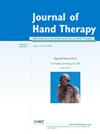Quantifying thenar muscle biomechanical properties: Sex-based variations and implications for grip strength
IF 1.8
4区 医学
Q2 ORTHOPEDICS
引用次数: 0
Abstract
Background
Quantifying the biomechanical properties of the thenar muscle can provide valuable insight into hand assessment methods.
Purpose
This study aimed to examine the reliability of myotonometer measurements in determining the biomechanical properties (tone, stiffness and elasticity) of thenar muscles in healthy individuals and explore sex-based variations. Additionally, it assessed the relationship between pinch strength and these properties.
Study Design
Cross-sectional reliability study.
Methods
Fifty-five healthy young adult participants were recruited. Biomechanical properties of the abductor pollicis brevis and flexor pollicis brevis muscles — tone (Hz), stiffness (N/m), and elasticity (logarithmic decrement)—were measured using MyotonPRO, while pinch strength was assessed using a Baseline pinch gauge bilaterally. For intrarater reliability, the first rater (R1), conducted two sets of measurements at 30-minute intervals. Inter-rater reliability was evaluated by the second rater (R2) performing a set of measurements between R1's two sets.
Results
Fifty participants [mean age = 22.84 (1.01) years, mean body mass index = 20.86 (2.82) kg/m²] completed the study. Test-retest reliability for the biomechanical properties of the abductor pollicis brevis and flexor pollicis brevis muscles showed good to excellent consistency (ICCs: 0.78-0.97). Inter-rater reliability demonstrated sufficient consistency across (ICCs: 0.78-0.93). Sex-based differences were observed on the nondominant side, with males exhibiting lower logarithmic decrement scores for both muscles (p < 0.05). Negative correlations were found between pinch strength and abductor pollicis brevis logarithmic decrement scores on both sides (p < 0.05).
Conclusions
The study confirms the reliability of MyotonPRO in evaluating the mechanical properties of the thenar muscle in healthy subjects, with good to excellent consistency. Sex-based differences in elasticity, along with the positive correlation between pinch strength, underscore the importance of sex-specific considerations, suggesting elasticity may be considered a key factor in grip strength improvement.
Trial Registration
ClinicalTrial.gov/NCT06004635
量化大鱼际肌肉的生物力学特性:握力的性别差异和含义。
背景:量化大鱼际肌肉的生物力学特性可以为手部评估方法提供有价值的见解。目的:本研究旨在检验肌张力计测量在确定健康个体大鱼际肌肉生物力学特性(张力、刚度和弹性)方面的可靠性,并探讨性别差异。此外,它还评估了夹紧强度与这些性能之间的关系。研究设计:横断面可靠性研究。方法:招募55名健康青年受试者。使用MyotonPRO测量拇短外展肌和拇短屈肌的生物力学特性——张力(Hz)、刚度(N/m)和弹性(对数递减),同时使用Baseline捏压仪评估双侧捏压强度。为了提高井内可靠性,第一等级(R1)每隔30分钟进行两组测量。评估者之间的信度由第二评估者(R2)在R1的两组之间进行一组测量来评估。结果:50名参与者[平均年龄=22.84(1.01)岁,平均体重指数=20.86 (2.82)kg/m²]完成了研究。拇短外展肌和拇短屈肌的生物力学特性的重测信度显示出良好至极好的一致性(ICCs: 0.78-0.97)。评估者之间的信度显示出足够的一致性(ICCs: 0.78-0.93)。在非优势侧观察到基于性别的差异,男性在两种肌肉上表现出较低的对数递减分数(结论:该研究证实了MyotonPRO在评估健康受试者大鱼际肌肉力学性能方面的可靠性,具有良好到极好的一致性。基于性别的弹性差异,以及捏紧强度之间的正相关关系,强调了性别特异性考虑的重要性,表明弹性可能被认为是提高握力的关键因素。试验注册:ClinicalTrial.gov/NCT06004635。
本文章由计算机程序翻译,如有差异,请以英文原文为准。
求助全文
约1分钟内获得全文
求助全文
来源期刊

Journal of Hand Therapy
医学-外科
CiteScore
3.50
自引率
10.00%
发文量
65
审稿时长
19.2 weeks
期刊介绍:
The Journal of Hand Therapy is designed for hand therapists, occupational and physical therapists, and other hand specialists involved in the rehabilitation of disabling hand problems. The Journal functions as a source of education and information by publishing scientific and clinical articles. Regular features include original reports, clinical reviews, case studies, editorials, and book reviews.
 求助内容:
求助内容: 应助结果提醒方式:
应助结果提醒方式:


